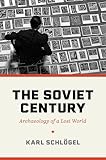The Soviet Century : Archaeology of a Lost World / Karl Schlögel.
Material type: TextPublisher: Princeton, NJ : Princeton University Press, [2023]Copyright date: ©2021Description: 1 online resource (928 p.) : 85 b/w illus. 2 mapsContent type:
TextPublisher: Princeton, NJ : Princeton University Press, [2023]Copyright date: ©2021Description: 1 online resource (928 p.) : 85 b/w illus. 2 mapsContent type: - 9780691232386
- HISTORY / Russia & the Former Soviet Union
- Crematoria
- Datcha
- GULAG
- Gorki‐Park
- Kommunalka
- Lubjanka
- Petrograd 1917
- Soviet Chanel
- Soviet Encyklopedia
- Soviet Fashion
- Soviet Sanatorium
- Soviet grafitti
- Soviet interieurs
- Soviet museums
- Soviet perfume
- Soviet railways
- Soviet rituals
- Soviet soundscapes
- Soviet way of live
- The philosophical steamboat
- online - DeGruyter
| Item type | Current library | Call number | URL | Status | Notes | Barcode | |
|---|---|---|---|---|---|---|---|
 eBook
eBook
|
Biblioteca "Angelicum" Pont. Univ. S.Tommaso d'Aquino Nuvola online | online - DeGruyter (Browse shelf(Opens below)) | Online access | Not for loan (Accesso limitato) | Accesso per gli utenti autorizzati / Access for authorized users | (dgr)9780691232386 |
Browsing Biblioteca "Angelicum" Pont. Univ. S.Tommaso d'Aquino shelves, Shelving location: Nuvola online Close shelf browser (Hides shelf browser)

|

|

|

|

|

|

|
||
| online - DeGruyter Theoretical Foundations of Corporate Finance / | online - DeGruyter The Art of Chinese Philosophy : Eight Classical Texts and How to Read Them / | online - DeGruyter Picasso and Truth : From Cubism to Guernica / | online - DeGruyter The Soviet Century : Archaeology of a Lost World / | online - DeGruyter College : What It Was, Is, and Should Be - Second Edition / | online - DeGruyter Blue : The History of a Color / | online - DeGruyter Green : The History of a Color / |
Frontmatter -- CONTENTS -- Translator’s Acknowledgements -- Abbreviations -- Preface -- Introduction: Archaeology of a Vanished World -- I. Shards of Empire -- II. Highway of Enthusiasts -- III. Soviet Sign-Worlds -- IV. The Life of Things -- V. Oases of Freedom -- VI. Interiors -- VII. Landscapes, Public Spaces -- VIII. Big Data -- IX. Rituals -- X. Bodies -- XI. Kolyma: The Pole of Cold -- XII. The Solovetsky Special Camp—Laboratory of Extremes: Monastery Island as Concentration Camp -- XIII. Corridors of Power -- XIV. The Noise of Time -- XV. Alien Territory, Contact Zones, In-Between Worlds -- XVI. The Railroads of Empire: Time Travel Back into the Russian Twentieth Century -- XVII. Red Cube: The Lenin Mausoleum as Keystone -- XVIII. The Lubyanka Project: Design for a Musée Imaginaire of Soviet Civilisation -- Acknowledgements -- Notes -- Selected Reading -- Index
restricted access online access with authorization star
http://purl.org/coar/access_right/c_16ec
An encyclopedic and richly detailed history of everyday life in the Soviet UnionThe Soviet Union is gone, but its ghostly traces remain, not least in the material vestiges left behind in its turbulent wake. What was it really like to live in the USSR? What did it look, feel, smell, and sound like? In The Soviet Century, Karl Schlögel, one of the world’s leading historians of the Soviet Union, presents a spellbinding epic that brings to life the everyday world of a unique lost civilization.A museum of—and travel guide to—the Soviet past, The Soviet Century explores in evocative detail both the largest and smallest aspects of life in the USSR, from the gulag, the planned economy, the railway system, and the steel city of Magnitogorsk to cookbooks, military medals, prison camp tattoos, and the ubiquitous perfume Red Moscow. The book examines iconic aspects of Soviet life, including long queues outside shops, cramped communal apartments, parades, and the Lenin mausoleum, as well as less famous but important parts of the USSR, including the Great Soviet Encyclopedia, the voice of Radio Moscow, graffiti, and even the typical toilet, which became a pervasive social and cultural topic. Throughout, the book shows how Soviet life simultaneously combined utopian fantasies, humdrum routine, and a pervasive terror symbolized by the Lubyanka, then as now the headquarters of the secret police.Drawing on Schlögel’s decades of travel in the Soviet and post-Soviet world, and featuring more than eighty illustrations, The Soviet Century is vivid, immediate, and grounded in firsthand encounters with the places and objects it describes. The result is an unforgettable account of the Soviet Century.
Mode of access: Internet via World Wide Web.
In English.
Description based on online resource; title from PDF title page (publisher's Web site, viewed 29. Mai 2023)


